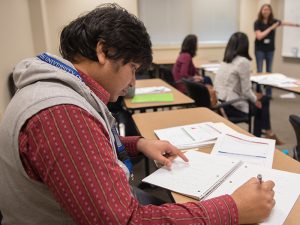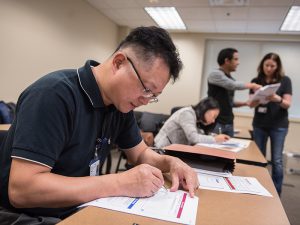 Jeannette Simino is an assistant professor of data science at the University of Mississippi Medical Center. After earning a PhD in statistics from Florida State University, she completed a postdoctoral fellowship in cardiovascular genetic epidemiology at Washington University School of Medicine. In her current role, Simino investigates the genetic architecture of Alzheimer’s Disease biomarkers and cognitive aging using data from the Atherosclerosis Risk in Communities (ARIC) Study.
Jeannette Simino is an assistant professor of data science at the University of Mississippi Medical Center. After earning a PhD in statistics from Florida State University, she completed a postdoctoral fellowship in cardiovascular genetic epidemiology at Washington University School of Medicine. In her current role, Simino investigates the genetic architecture of Alzheimer’s Disease biomarkers and cognitive aging using data from the Atherosclerosis Risk in Communities (ARIC) Study.
The day our graduate program was approved, I cried. Not tears of joy … I was petrified. Teaching was my nemesis (I am wrought with public speaking anxiety!) and I was assigned the dreaded Statistical Inference I course. I hadn’t cracked the Casella and Berger textbook in 15 years and was currently masquerading as a genetic epidemiologist.
Suffice it to say, I liked statistics at one time; I hazily remember earning a doctorate in the subject eons ago. I greatly enjoyed my inference courses at both Case Western Reserve and Florida State University. The instructors were statistical geniuses who loved studying theory for its logical beauty. However, I—a non-brainiac and mere mortal—needed to teach statistical inference to students in a blended biostatistics and data science program. These students were wisely pragmatic and wanted to know how to apply each concept in the real world. How would I teach them the pertinent information without suffering a nervous breakdown or creating a classroom of zombies?
Then it dawned on me.… Teach the course just like you would teach SAS or R programming. Often in programming classes, the instructor teaches a concept or command, runs some example code, and requires students to complete new exercises right in front of them. After everyone exhibits mastery, the instructor moves on to the next concept or command. Why wouldn’t that work in a statistical inference class? I could teach the students a concept, work out a practical example or two, and make them work out a practice problem for five or 10 minutes to gauge their mastery.
The first day of class, I was nervous. Would the students actually try the exercises, or would they sneer and put secret voodoo curses on me? When we hit the first “give it a try” slide, I cautiously instructed them to go ahead and try to solve the problem. I half expected them to whip out their cellphones, put on headphones, or take a nap. Instead, the five students (some of the kindest people you will ever meet) graciously worked on the problem and compared their answers with their tablemates’ answers. I was ecstatic; they were actually listening to me and learning something!
As the semester progressed, my confidence grew. I became emboldened to structure the whole course in this manner. Most class sessions contained at least two or three “give it a try” problems. This enabled me to work one-on-one with students to clarify any misunderstandings (As a bonus, talking with the students eased my anxiety!). Sometimes students would nod along to my lecture, thinking they understood everything, only to get stuck when trying to complete the exercise.
Not to say the method is perfect. I did not cover as much material as anticipated, although that was partly attributable to my lack of teaching experience. Next year, I will extend my class time from 1.25 hours to 1.5 hours to accommodate the “lab” time. But this method got the students engaged as both learners and teachers to their peers. They did not dread coming to my class (or they hid it well), they excelled on their exams, and they gave me decent teaching evaluations (Whew, my tenure packet survived round one!). We grew to trust each other. There were no disparaging comments when a student asked a question or had trouble grasping a concept. The other students jumped in with alternate explanations because we were a team! I survived weeks without suffering any episodes of anxiety (My bottle of Xanax was barely touched.).
So now what’s left? Besides getting The Cranberries’ tune out of my head (Zombie), I need to edit all the typos, create lecture notes for the omitted sections, and reorganize the material for next year, when I will again teach statistical inference like SAS and cross my fingers that the next group of students will be just as receptive to this teaching method. But after a long semester, I need a vacation!






Leave a Reply